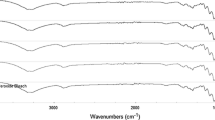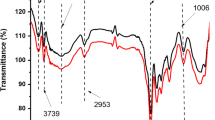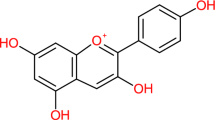Abstract
Use of enzymes in different parts of textile finishing processes has become popular, and several enzymes have been introduced into the textile industry. This study aimed to carry out the whole fabric pretreatment process in a single bath containing different enzymes. Ultrasonic cavitation was also tested to show its effect on enzyme-based finishing of cotton fabric. After optimization of the enzyme-based ultrasound-aided finishing, the fabrics were also colored in the same bath using natural dyes of pomegranate peel, nutshell, orange tree leaf, and alkanet root. Finally, it was observed that ultrasound-aided biopreparation of cotton fabric could provide sufficient pretreatment results. Coloration of these fabrics could be achieved with the use of natural dyes in the same bath as biopreparation.






Similar content being viewed by others
References
Adeel S, Ali S, Bhatti IA, Zsila F (2009) Dyeing of cotton fabric using pomegranate (Punica granatum) aqueous extract. Asian J Chem 21:3493–3499
Alasalvar C, Shahidi F, Ohshima T, Wanasundara U, Yurttas HC, Liyanapathirana CM, Rodrigues FB (2003) Turkish Tombul hazelnut (Corylus avellana L.) 2. Lipid characteristics and oxidative stability. J Agric Food Chem 51:3797–3805
Ali S, Hussain T, Nawaz R (2009) Optimization of alkaline extraction of natural dye from Henna leaves and its dyeing on cotton by exhaust method. J Clean Prod 17:61–66
Aly AS, Moustafa AB, Hebeish A (2004) Bio-technological treatment of cellulosic textiles. J Clean Prod 12:697–705
Aniş P, Davulcu A, Eren H.A (2008) Enzymatic pre-treatment of cotton. Part 1. Desizing and glucose generation in desizing liquor. Fibres Text East Eur 16 4(69):100–103
Bahtiyari Mİ, Benli H (2012) Use of orange tree leaves in dyeing of viscose fabrics. International Antalya Fashion and Textile Design Biennial, Antalya
Bankar SB, Mahesh VB, Singhal RS, Ananthanarayan L (2009) Glucose oxidase—an overview. Biotechnol Adv 27:489–501
Bruni S, Guglielmi V, Pozzia F, Mercurib AM (2011) Surface-enhanced Raman spectroscopy (SERS) on silver colloids for the identification of ancient textile dyes. Part II: pomegranate and sumac. J Raman Spectrosc 42:465–473
Chung C, Lee M, Choe EK (2004) Characterization of cotton fabric scouring by FT-IR ATR spectroscopy. Carbohydr Polym 58:417–420
DIN 53924:1997 Testing of textiles—velocity of soaking water of textile fabrics (method by determining the wicking height). Berlin, Deutsches Institut für Normung E.V.
Eren HA, Ozturk D (2011) The evaluation of ozonation as an environmentally friendly alternative for cotton preparation. Text Res J 81:512–519
Etters JN, Condon BD, Husain PA, Lange NK (1999) Alkaline pectinase: key to cost-effective, environmentally friendly preparation. Am Dyest Rep 19–23
Hoondal GS, Tiwari RP, Tewari R, Dahiya N, Beg QK (2002) Microbial alkaline pectinases and their industrial applications:a review. Appl Microbiol Biotechnol 59:409–418
ISO 105-X12:1993 Textiles–tests for color fastness, Part X12: color fastness to rubbing. Geneva, International Organization for Standardization
ISO 105-B02:1994 Textiles–tests for color fastness, Part B02: color fastness to artificial light. Geneva, International Organization for Standardization
ISO 105-E04:1994 Textiles–tests for color fastness, Part E04: color fastness to perspiration. Geneva, International Organization for Standardization
ISO 105-C10:2006 Textiles–tests for color fastness—Part C10: color fastness to washing with soap or soap and soda, test condition: test A (1). Geneva, International Organization for Standardization
ISO 2062:2009 Textiles-yarns form packages-determination of single-end breaking force and elongation at break
Jayani RS, Saxena S, Gupta R (2005) Microbial pectinolytic enzymes: a review. Process Biochem 40:2931–2944
Karaboğa C, Körlü AE, Duran K, Bahtiyari Mİ (2007) Use of ultrasonic technology in enzymatic pretreatment processes of cotton fabrics. Fibres Text East Eur 15(4):97–100
Moore SB, Ausley LA (2004) Systems thinking and green chemistry in the textile industry: concepts, technologies and benefits. J Clean Prod 12:585–601
Padfield T, Landi S (1966) The light-fastness of the natural dyes. Stud Conserv 11:181–196
Rekaby M, Salem AA, Nassar SH (2009) Eco-friendly printing of natural fabrics using natural dyes from alkanet and rhubarb. J Text Inst 100:486–495
Samanta AK, Agarwal P (2009) Application of natural dyes on textiles. Indian J Fibre Text Res 34:384–399
Saravanan D, Vasanthi NS, Raja KS, Das A, Ramachandran T (2010) Bleaching of cotton fabrics using hydrogen peroxide produced by glucose oxidase. Indian J Fibre Text Res 35:281–283
Saravanan D, Sivasaravanan S, Prabhu MS, Vasanthi NS, Raja KS, Das A, Ramachandran T (2012) One-step process for desizing and bleaching of cotton fabrics using the combination of amylase and glucose oxidase enzymes. J Appl Polym Sci 123:2445–2450
Smith KJ (1997) Colour order systems, colour spaces, colour difference and colour scales. In: McDonald R (Ed) Colour physics for industry, 2nd edn. JSDC, Bradford, England. pp. 121–208 (ISBN 0 901956 70 8)
Tutak M, Benli H (2012) Dyeing properties of textiles by Turkish hazelnut (Corylus colurna): leaves, coat, shell and dice. Color Technol 128:454–458
Vajnhandl S, Le Marechal AM (2005) Ultrasound in textile dyeing and decolouration/mineralization of textile dyes. Dyes Pigment 65:89–101
Vouters M, Rumeau P, Tierce P, Costes S (2004) Ultrasounds: an industrial solution to optimise costs, environmental requests and quality for textile finishing. Ultrason Sonochem 11:33–38
Wang Q, Fan X, Gao W, Chen J (2006) Characterization of bioscoured cotton fabrics using FT-IR ATR spectroscopy and microscopy techniques. Carbohydr Res 341:2170–2175
Acknowledgments
This work was supported by Research Fund of the Erciyes University. Project Number: FDK-2014-5156.
Author information
Authors and Affiliations
Corresponding author
Rights and permissions
About this article
Cite this article
Benli, H., Bahtiyari, M.İ. Use of ultrasound in biopreparation and natural dyeing of cotton fabric in a single bath. Cellulose 22, 867–877 (2015). https://doi.org/10.1007/s10570-014-0494-x
Received:
Accepted:
Published:
Issue Date:
DOI: https://doi.org/10.1007/s10570-014-0494-x




